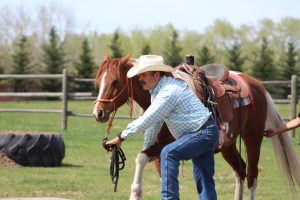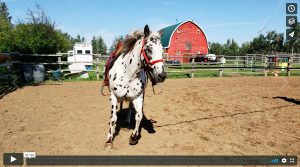I’d like to introduce five of our Strategies for Success that we follow when we start working with horses on obstacles or anything new and unknown.
- We build it in the groundwork, then ride it in the saddle.
- We never force a horse to go on, over or though something they’re scared of. We do go forward when the horse is in release and following our focus.
- Find ground zero. This is the position, proximity to an obstacle, or a maneuver that we know the horse can achieve. We can always start successfully from our ground zero point.
- We define success as, “anytime the horse tries for us,” and reward and encourage our horse when he tries.
- We allow the horse the time he needs to investigate the obstacle before we continue to ask him forward.
In this article, we’re going to focus on #2. It’s a good idea to read Part 1 first.
Someone rides their horse up to an obstacle. The horse is afraid of it and tries to turn away. The rider might kick to get the horse to move or jerk on the reins when the horse isn’t straight. The horse still struggles, so he’s taken away from the obstacle and run in circles to make him think the obstacle is a better idea.
Frustration, fear of failure and ego cause us to act that way. Looking at it from a leadership perspective, obviously the horse isn’t getting a good day here. Let’s change it up and:
- Gain an understanding of how horses think and perceive fear, and
- Develop our leadership skills to help us work with horses.
Let’s work together to eliminate these unfortunate scenarios. We’ll start by focusing not only on the success of the horse, but where we’re physically going (looking beyond the obstacle, not at it).
What we sometimes forget is that we’re always training the horse. The lesson he’ll take away from this scenario is that when he’s scared, his human turns into a vicious predator. A predator that is trying to force him into something that he believes will kill him. Horses – like us – learn by repetition. If our scenario plays out several times, he’ll quickly learn to expect the rider’s negative behavior and react in advance. Clearly we want to avoid that.
You might be thinking, “Well, how am I ever going to get him over it if I don’t force him?” As you’ve likely guessed by this point, there is a more positive and successful approach. The secret is in the style of training.
Begin by realizing that the obstacle is simply a pressure for your horse. The answer then, is to teach your horse – over time – to handle greater degrees of pressure. You’ll find details on how to expose a horse to pressure in order to train him in this article. Note that we do not want to train the horse to ignore pressure. Any thinking creature can only ignore pressure to a certain level. It makes sense than, that increasing that level your horse can handle is the correct option. We’ll teach our horse what to do with pressure; we’ll train that, when pressure presents itself, our horse releases to it and follows our focus. This is a structured core component of my obstacle and trail clinics.
While we do need to expose our horses to pressure in order to teach them how to handle pressure, we do so at a rate that allows them to progress, using pressures that approach but do not exceed their capability of handling them. The technique is very similar to exposure therapy in humans. Dr. Katharina Hauner (Department of Neurology, Northwestern University, Chicago) explains that fear is not removed instantaneously; instead working with fear requires conditioning over time.
And thus we work so with our horses. Over repeated sessions, we can expose them to pressures, asking for the same action each time: release to tension (created by fear) and focus on / follow us. As trainers and leaders, we will stay completely positive and encourage our horse, thus utilizing these sessions to support trust building in the best possible way. The horse will learn that you are a trusted herd leader that makes good decisions about things that scare the herd. They will come to depend on you to help them through struggles (instead of expecting you’ll lose your cool, or learning to avoid you altogether).
Conditioning a non-fear response can be taught for a single obstacle. But that won’t help you with the next obstacle that the horse is afraid of. You’d have to start all over again. Again, the difference here is in the training style. What we do is built a mechanism for all situations your horse might become scared or anxious.
When you can cause your followers to release tension, trust and follow you in stressful situations, then you can have a successful team. Not only with horses, but with people as well. Once we’ve got that going for us, then all obstacles stand a much better chance of success the first time.
Sure, the horse might have questions or anxieties about something new or unrecognizable. They are a prey animal with limited comprehension and unable to make abstract associations. Their actions and instincts have kept them alive for millennia, and you can’t expect that to change in the 5 seconds you give a horse in front of an obstacle, right? Right. But when the horse knows that you will answer those anxieties with a positive, you’ve got it made.
Horses instinctively follow a leader. The herd has a leader that is responsible for making decisions on what the herd should do when a perceived threat is encountered. That leader must be you. The extent a horse will follow your leadership is based on successful repetitive experiences. Over time, many experiences and many miles, the horse can learn that you can be trusted in any situation.
We can certainly opt to leave experience to chance. Mother Nature will supply us with challenges whether we want them or not. That being the case, we can also opt to train for it. And that is the basis of our Obstacle and Trail clinics: we simulate those challenges in a controlled environment to provide the horse repetitive training (and thus earn your trust) and to allow you to build the confidence to handle anything.Saskia, a client that’s trained with me for several years, sent me this message after an extended trail riding trip:
 We had 9 wonderful rides at Indian Graves! The first 3 days Sam was scared of everything and very reactive. It scared me a bit but we kept on repeating what you taught us. I kept on putting his focus on something else, stayed calm and he slowly built so much confidence over those 9 days. I felt so good and so much more connected to him 🙂
We had 9 wonderful rides at Indian Graves! The first 3 days Sam was scared of everything and very reactive. It scared me a bit but we kept on repeating what you taught us. I kept on putting his focus on something else, stayed calm and he slowly built so much confidence over those 9 days. I felt so good and so much more connected to him 🙂
What’s great about Saskia’s story is that she took all her learning to practical purpose in a real trail environment (this is also what our Trail 2 clinics are for).
So how can we handle getting a horse over an obstacle with no muss or fuss? It’s a multi-step process that will always leave you and your horse feeling positive:
- The horse believes we are the herd leader – required before we can legitimately ask anything of our horse;
- We teach the horse that when he’s faced with something scary, the answer is to release tension and follow our focus. When our focus is forward, the horse has a direction to move.
- The amount of pressure we’ll be able to ask the horse to follow us into or through depends on the amount of pressure we’ve trained him to handle – and that takes time, but it’s time well spent because it lasts forever.
- We ask the horse nothing more than to try for us. And this – we’ll get into in the next articles in this series.

The photo here is of me asking a mare to step up onto a teeter totter. It’s a great example of asking a horse to release tension (note the SOFT downward connection on the lead-rope) and my clear focus on where our herd is going – to the other side of the obstacle.
Scott Phillips
November, 2018
Make sure that you have your free account on our website, then click here to watch the video. Here’s another one to illustrate the point.

